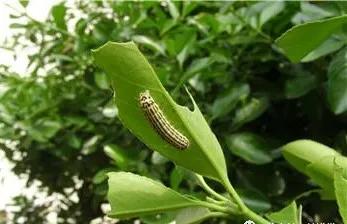The large-leaved boxwood spotted moth overwinters with eggs. Most of its overwintering eggs are concentrated on the 1 to 2 year old branches of the host plant, fresh branches and petioles. The eggs of the large-leaved boxwood spotted moth are mostly arranged in blocks and strips. Usually, by mid-to-late March of the following year, its overwintering eggs will hatch. Late March is the peak incubation period for the eggs of the large-leaf boxwood moth, but a small number of eggs hatch in early April. In general, the same egg is hatched in 2-3 days. The hatching larvae cluster in the branches to make harms and feed on new leaves. Therefore, the harm period of the larvae of the large-leaf boxwood spotted moth is in mid-to-late April.

Fig. 1: Large-leaf boxwood spotted moth larvae front
The larval stage of the large-leaved boxwood moth is generally 30-35 days. By mid-to-late May, the mature larvae will begin to pupate in a cocoon. The pupae of the large-leaf boxwood spotted moth is mostly concentrated in the soil cracks around the rhizosphere of about 2 cm to 3 cm on the surface or in the dry weeds. The pupal stage can usually last up to six months. Adults will feather in late October, while peak feathering will reach in early to mid-November. After the adult of the large-leaf boxwood spotted moth feathers, it will mate and lay eggs.
Figure 2: Side of the large-leaf boxwood moth
In general , the larvae of the large-leaf boxwood moth hatch and begin feeding. The hatching larvae will only eat the leaf flesh of the young buds and young leaves, leaving only the epidermis and veins of the lower leaves, and will gradually eat the young leaves later. The 1-3 instar larvae of the large-leaf boxwood moth are a cluster hazard, so it is common to see 1 egg mass larvae gathering on the adjacent 2-3 young shoots for feeding, usually starting at the tip and then feeding downwards. After 3 years of age, the food intake of the large-leaved boxwood moth will be greatly increased, and the damage will begin to spread. Therefore, at this time, it is often possible to see the buds and leaves of the host plant being nibbled into a network, while the leaves will appear porous and absent. At this time, such as the large-leaf boxwood spotted moth with a large population density and in the binge eating period, the leaves and young branches of the host plant will be eaten up completely, and only the petiole will be left, resulting in the bald branches of the host plant. At this time, when the affected host plant encounters a high temperature and dry climate, it often causes the death of the entire plant. In addition, in the case of insufficient food, the large-leaved boxwood moth can also be transformed into a plant for harm, so it often causes the lack of garden landscape, so it is necessary to actively carry out prevention and control work.
Fig. 3: Large-leaved boxwood is harmful
Prevention and control methods:
1. Actively do a good job in predicting and forecasting the pest, and protect and make good use of the natural enemies of the large-leaved boxwood spotted moth. The larvae of the hatching large-leaf boxwood moth have the habit of clustering pests, which can be combined with pruning and shaping, and the density of the insect mouth can be greatly reduced by pruning the branches, shoots and leaves of the insects.
2. Strengthen the daily maintenance and management of seedlings. The wintering eggs of the large-leaved boxwood spotted moth can be used to be mostly attached to the fresh branches of the year, and from December to February, combined with the work of clearing the garden in winter and spring, the dead branches and branches attached to the overwintering eggs are manually cut off to eliminate the overwintering insect eggs. It should be noted here that the pruned branches, shoots and leaves should be destroyed in a concentrated manner to reduce their harm.
3. The hatching larvae of the large-leaf boxwood spotted moth like to cluster, and the larvae will spit and droop when they are shaken and frightened. Therefore, it is possible to artificially shake the branches and kill these clusters of larvae.
4. Adults of the large-leaved boxwood spotted moth have phototropism habits. Therefore, during the occurrence period of adults of the large-leaf boxwood spotted moth, in the area where the host plants are more concentrated, booby-traps can be carried out by setting up frequency vibration insecticidal lights.
5, chemical control: the application of drugs to control the large-leaved boxwood moth, the best period is in its larval stage, so at this time to actively carry out control work. It can be sprayed by: 20% methrine indinale (Reinpin Anruivir) suspension 1000 times liquid, or 22% thiamethiasis fluoride (Lane Ping Anrika) suspension 3500-5000 times liquid, 2.5% cypermethrin emulsion 2000-2500 times liquid, or 25% urea suspension 2000-2500 times liquid, or 20% carbohydrazide suspension 1500-2000 times liquid spray, it should be noted that the drug should be used and controlled in sunny weather. In addition, the medication should be thorough, and the agent should be sprayed evenly on the center of the insect infestation and the surrounding branches, taking care not to leak the leaves of the lower part of the host plant.